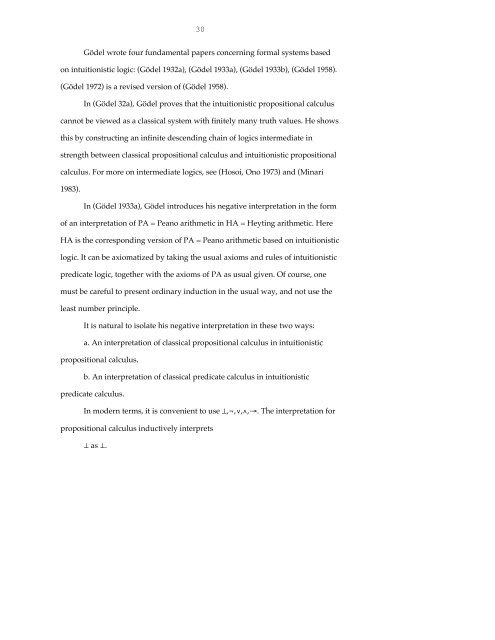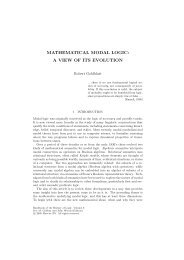my forty years on his shoulders - Department of Mathematics
my forty years on his shoulders - Department of Mathematics
my forty years on his shoulders - Department of Mathematics
- No tags were found...
Create successful ePaper yourself
Turn your PDF publications into a flip-book with our unique Google optimized e-Paper software.
30Gödel wrote four fundamental papers c<strong>on</strong>cerning formal systems based<strong>on</strong> intuiti<strong>on</strong>istic logic: (Gödel 1932a), (Gödel 1933a), (Gödel 1933b), (Gödel 1958).(Gödel 1972) is a revised versi<strong>on</strong> <strong>of</strong> (Gödel 1958).In (Gödel 32a), Gödel proves that the intuiti<strong>on</strong>istic propositi<strong>on</strong>al calculuscannot be viewed as a classical system with finitely many truth values. He showst<strong>his</strong> by c<strong>on</strong>structing an infinite descending chain <strong>of</strong> logics intermediate instrength between classical propositi<strong>on</strong>al calculus and intuiti<strong>on</strong>istic propositi<strong>on</strong>alcalculus. For more <strong>on</strong> intermediate logics, see (Hosoi, Ono 1973) and (Minari1983).In (Gödel 1933a), Gödel introduces <strong>his</strong> negative interpretati<strong>on</strong> in the form<strong>of</strong> an interpretati<strong>on</strong> <strong>of</strong> PA = Peano arithmetic in HA = Heyting arithmetic. HereHA is the corresp<strong>on</strong>ding versi<strong>on</strong> <strong>of</strong> PA = Peano arithmetic based <strong>on</strong> intuiti<strong>on</strong>isticlogic. It can be axiomatized by taking the usual axioms and rules <strong>of</strong> intuiti<strong>on</strong>isticpredicate logic, together with the axioms <strong>of</strong> PA as usual given. Of course, <strong>on</strong>emust be careful to present ordinary inducti<strong>on</strong> in the usual way, and not use theleast number principle.It is natural to isolate <strong>his</strong> negative interpretati<strong>on</strong> in these two ways:a. An interpretati<strong>on</strong> <strong>of</strong> classical propositi<strong>on</strong>al calculus in intuiti<strong>on</strong>isticpropositi<strong>on</strong>al calculus.b. An interpretati<strong>on</strong> <strong>of</strong> classical predicate calculus in intuiti<strong>on</strong>isticpredicate calculus.In modern terms, it is c<strong>on</strong>venient to use ⊥,¬,∨,∧,→. The interpretati<strong>on</strong> forpropositi<strong>on</strong>al calculus inductively interprets⊥ as ⊥.
















